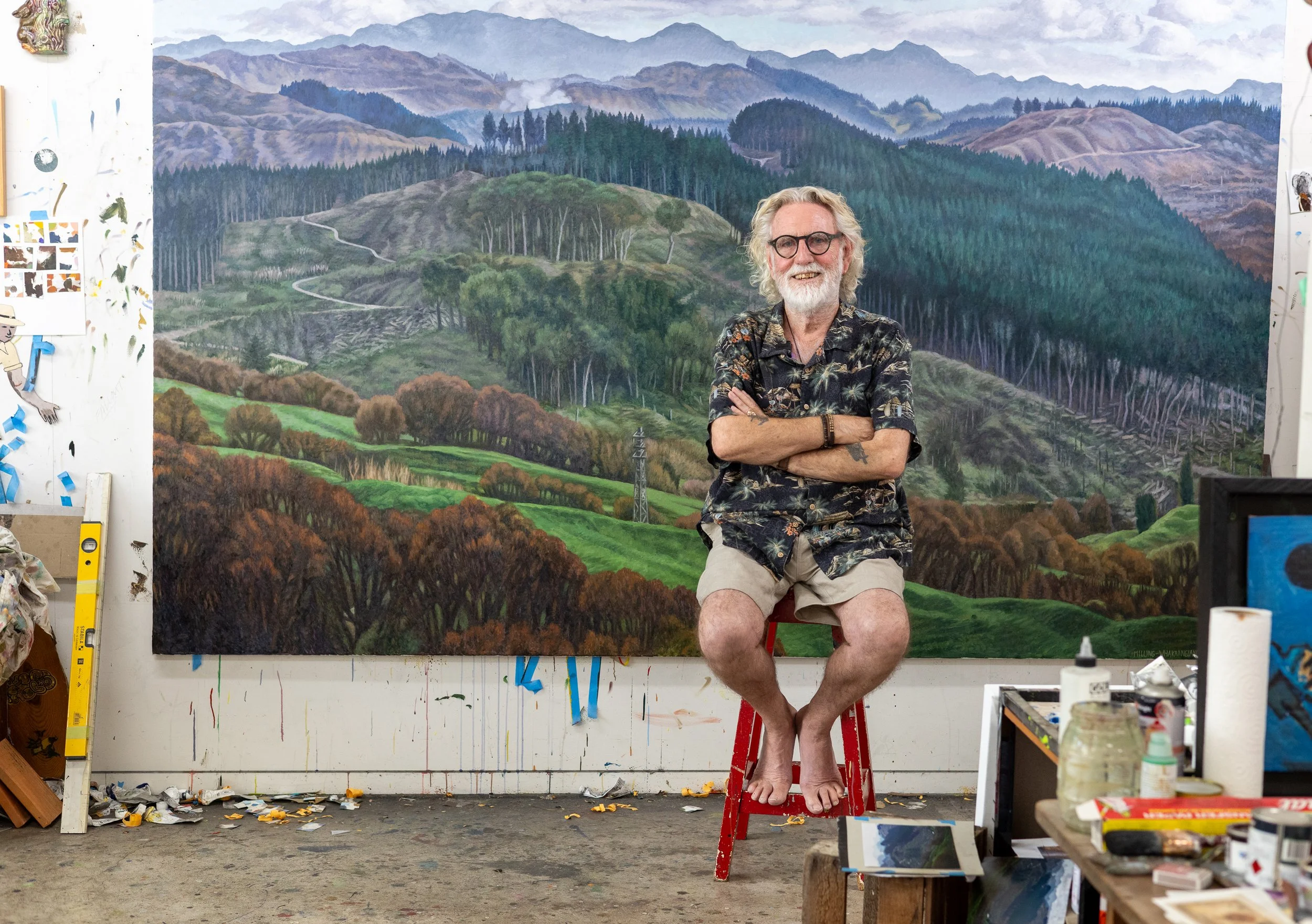Studio Visit: Dick Frizzell
We recently visited Dick Frizzell’s studio for a tour and insight into his creative process, getting an insight into the artist’s work, influences, recurring themes, and playful reworking of familiar Kiwi imagery.
Webb’s has proudly auctioned hundreds of Dick Frizzell’s works over the years. With his memoir Hastings: A Boy’s Own Adventure newly published — and many of his works popping up in our auction catalogues — it’s the perfect moment to revisit his influences, recurring themes, and the playful, subversive approach that has made his work so iconic in Aotearoa’s art scene
Dick Frizzell has inhabited that intersection between commercial and pop art for decades; enjoying the hustle and bustle, the bombastic billboards and the brightly coloured comic strips that make up his peculiar, somewhat nostalgic vision of Kiwiana through the lens of United States advertising and pop art.
Some have said Frizzell is a living protest against the modernist art canon of the 50s and 60s which was taught to him at Ilam School of Fine Arts. It was an era that often equated ‘obfuscation’ with ‘high art’ and anything with a whiff of populism—like the commercial illustration he practiced for many years—to lesser art forms.
Throughout Frizzell’s career he has frequently quoted and paid homage to pop artists, designers, illustrators and others who inhabited a similarly ‘low rung’ in modernism’s loftier canon. Walt Disney, Andy Warhol, Keith Haring, Orla Kiely, fellow ad-man Marcus King, and iconic comic strips have all appeared in Dick’s oeuvre with a particular Kiwi twang and penchant for a good joke.
Over 30,000 reproductions of Mickey to Tiki Tu Meke—the 1995 watercolour that deconstructs the face of Mickey Mouse until it has morphed into a Māori tiki— were reportedly sold between 1997 and 2017. That is not counting the other ‘merch’ that Frizzell’s successful franchise has managed to pull off: posters, t-shirts, hats… a skateboard deck. The Four Square Man series—Frizzell’s Warholian treatment of the cartoon mascot for New Zealand grocery chain Four Square—has become almost inseparable from the original logo.
4 of the 12 Dick Frizzell Works in Webb’s May Art Online auction catalogue
Dick Frizzell
untitled (Chair)
2005
oil on upholstery; enamel on wood
signed FRIZZELL and dated 05 in brushpoint lower right
700 x 650 x 645mm (widest points)
No Place Like Home
Live Auction | Monday 19 May, 6.30pm
Video Tour
Recently we had the pleasure of visiting Dick Frizzell's studio.
He gave us a tour of his works, space, and some insight into his creative process of how he transfers his vision from image-to-canvas and the joy he finds in reworking familiar images in unexpected ways.
His studio, filled with colour, sketches, and decades of work, offers a fascinating glimpse into the artist's mind and world.
To say Frizzell has been ‘prolific’ doesn’t quite do justice to a man who since the 1970s has had a go at almost every product and commercial collaboration, genre and ‘style’ under the sun: from wine labels and iPhone cases, to roadside signs; from tea towels to award-winning landscapes and from visual puns and punchlines to beautiful abstractions.
Within that ‘border-hopping’ and ‘nothing-is-sacred’ postmodernism, however, there is sometimes introspection and sometimes curiosity at how Americana has come to permeate and influence our own graphic design vocabulary and the popular culture it reflects.
Webb’s has had the privilege of consigning many of Frizzell’s creations: From wooden toys and editions of lithographs to Milling, the impressive 1987 oil on canvas of a seemingly innocuous forestry setting, to his vintage style comic-strip illustrations such as Girl in a Mirror to PA-KOW! a fibreglass, acrylic and varnish life-sized cow with Roy Lichtenstein aspirations.
The latest of such bombastic offerings here at Webb’s is, in true Frizzell-fashion, equally unexpected. As part of No Place Like Home—a touring exhibition and live auction bringing together everyday objects that have been re-contextualised, via art, to bring joy, beauty, and a witty playfulness to residential settings—the Art Department is bringing to auction Dick Frizzell’s 2005 Untitled (Chair).
According to Frizzell, he: Designed the fabric for a small homeware company in Hawkes Bay named ‘Esther Diamond’ for cushions and such. The maker of the chair David Moreland, who also heads the design department at Città — also lived in Hawkes Bay at the time really liked the pattern and wanted to use it on one of his designs.
The result uses Moreland’s now iconic chair design ‘Framed’ as its ready-made starting point, its material and structural simplicity making it seem almost ephemeral, while Frizzell’s intervention—a monochromatic pop art-styled, timber wall/fence on the upholstery—anchors the whole thing into a kind of cartoon-version of an architectural folly.
Recurring themes running through Frizzell’s practice in its many forms include dynamism, vibrancy, a somewhat nostalgic, bubble-gum infused fascination with the urban iconography that surrounds us, all in a language that is palatable, deeply unpretentious and often anarchic… all suffused with a lot of joy and an infectious playfulness.
Dick Frizzell’s 2005 Untitled (Chair) pictured front and centre as part of the No Place Like Home live art auction catalogue.
Urbis magazine Living With Art issue featuring the Framed armchair in Dick Frizzell woodgrain fabric.
Dick Frizzell’s Untitled (Chair) forms part of No Place Like Home. The live art auction that includes artworks celebrating the simple joys of home by artists who cover a wide spectrum of styles and periods—from Frances Hodgkins and D K Richmond to Karl Maughan and Teuane Tibbo. Furniture by local and international artist-designers such as David Trubridge and Fornasetti, add to the interdisciplinary richness of this highly engaging collection.
No Place Like Home
Live Art Auction | Monday 19 May, 6.30pm.
Dick Frizzell pictured with his newly published book, Hastings; A boy’s own adventure






















